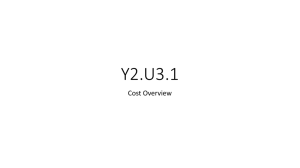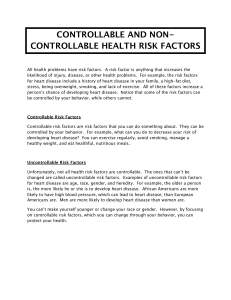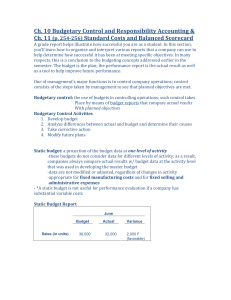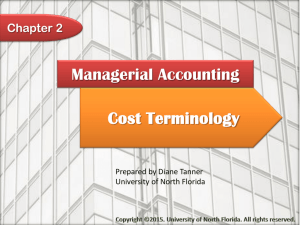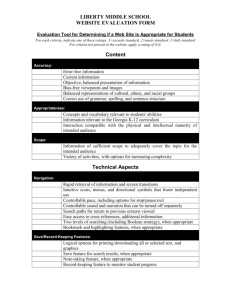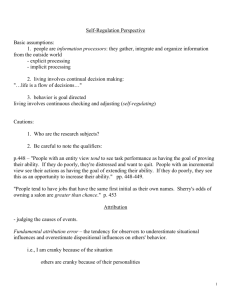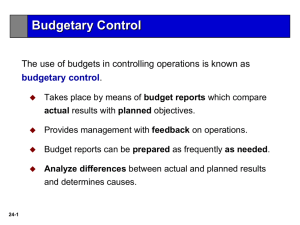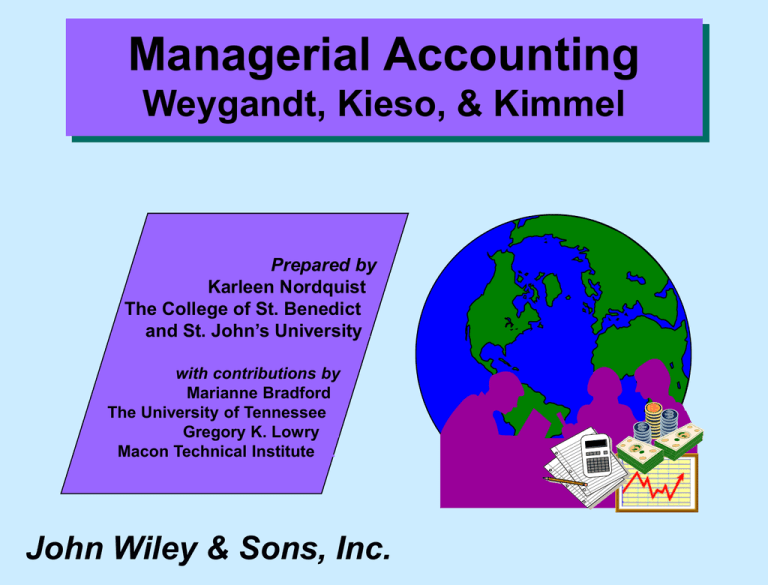
Managerial Accounting
Weygandt, Kieso, & Kimmel
Prepared by
Karleen Nordquist..
The College of St. Benedict...
and St. John’s University...
with contributions by
Marianne Bradford..
The University of Tennessee...
Gregory K. Lowry….
Macon Technical Institute…..
John Wiley & Sons, Inc.
Chapter 7
Budgetary Control and
Responsibility Accounting
Chapter 7
Budgetary Control and Responsibility
Accounting
After studying this chapter, you should be able to:
1 Describe the concept of budgetary control.
2 Evaluate the usefulness of static budget reports.
3 Explain the development of flexible budgets and the
usefulness of flexible budget reports.
4 Describe the concept of responsibility accounting.
Chapter 7
Budgetary Control and Responsibility
Accounting
After studying this chapter, you should be able to:
5 Indicate the features of responsibility reports for cost
centers.
6 Identify the content of responsibility reports for profit
centers.
7 Explain the basis and formula used in evaluating
performance in investment centers.
Preview of Chapter 7
Concept of Budgetary Control
Static Budget Reports
BUDGETARY
CONTROL AND
RESPONSIBILITY
ACCOUNTING
• Illustrations
• Uses and Limitations
Flexible Budgets
• Why Flexible Budgets?
• Development
• Case Study
• Reports
• Management by Exception
Preview of Chapter 7
Concept of Responsibility
Accounting
BUDGETARY
CONTROL AND
RESPONSIBILITY
ACCOUNTING
• Controllable vs. Noncontrollable
• Reporting System
Types of Responsibility
Centers
• Cost Centers
• Profit Centers
• Investment Centers
• Performance Evaluation
Study Objective 1
Describe the concept of budgetary
control.
Budgetary Control
The use of budgets in controlling operations is
known as budgetary control.
The centerpiece of budgetary control is the use of
budget reports that compare actual results with
planned objectives.
The budget reports provide the feedback needed
by management to see whether actual operations
are on course.
Budgetary Control
Budgetary control involves:
Developing budgets.
Analyzing the differences between actual and
budgeted results.
Taking corrective action.
Modifying future plans, if necessary.
Repeating the cycle.
Budgetary Control
Budgetary control works best when a company has
a formalized reporting system. The system
should:
Identify the name of the budget report, such as the
sales budget or the manufacturing overhead
budget.
State the frequency of the report, such as weekly
or monthly.
Specify the purpose of the report.
Indicate the primary recipient(s) of the report.
Budgetary Control Reporting
System
The schedule below illustrates a partial budgetary control system for a
manufacturing company. Note the emphasis on control in the reports
and the frequency of the reports.
Illustration 7-2
Name of
Report
Frequency
Sales
Weekly
Labor
Weekly
Scrap
Daily
Department
Monthly
Overhead costs
Selling expenses Monthly
Income
Statement
Monthly
and
quarterly
Purpose
Primary Recipient(s)
Determine whether sales
Top management and sales
goals are being met
manager
Control direct and indirect Vice president of production
labor costs
and production department
managers
Determine efficient use of
Production manager
materials
Control overhead costs
Department manager
Control selling expenses
Sales manager
Determine whether
income objectives are
being met
Top manager
Study Objective 2
Evaluate the usefulness of static
budget reports.
Static Budget Reports
A static budget is a projection of budget data
at one level of activity.
In such a budget, data for different levels of
activity are ignored.
As a result, actual results are always
compared with the budget data at the activity
level used in developing the master budget.
Static Budget Reports:
Illustration
To illustrate the role of a static budget in budgetary
control, we will use selected budget data for Hayes
Company prepared in Chapter 6.
Budget and actual sales data for the Kitchen-mate
product in the first and second quarters of 1999 are as
follows:
Sales
Budgeted
Actual
Difference
First Quarter
$180,000
179,000
$ 1,000
Second Quarter
$210,000
199,500
$ 10,500
Total
$390,000
378,000
$ 11,500
Illustration 7-3
Static Budget Reports:
Illustration
The sales budget report for Hayes Company’s 1st quarter is
shown below.
Illustration 7-4
Hayes Company
Sales Budget Report
For the Quarter Ended March 31, 1999
Product Line
Kitchen-matea
aIn
Budget
$180,000
Actual
$179,000
Difference
Favorable - F
Unfavorable - U
$1,000 U
practice, each product line would be included in the report.
The report shows that sales are $1,000 under budget – an
unfavorable result. Since the difference is less that 1% of
budgeted sales ($1,000/$180,000 =.0056), we will assume
that top management of Hayes Company will view the
difference as immaterial and take no specific action.
Static Budget Reports:
Illustration
The sales budget report for Hayes Company’s 2nd quarter
is shown below.
Hayes Company
Sales Budget Report
For the Quarter Ended March 31, 1999
Product Line
Kitchen-matea
aIn
Budget
$210,000
Actual
$199,500
Difference
Favorable - F
Unfavorable - U
$10,500 U
practice, each product line would be included in the report.
The second quarter shows that sales were $10,500 below
budget, which is 5% of budgeted sales
($10,500/$210,000). Top management may conclude that
the difference between budgeted and actual sales in the
second quarter merits investigation.
Static Budget Reports:
Illustration
Management’s analysis should start by asking the
sales manager the cause(s) of the shortfall. The
need for corrective action should be considered.
For example, management may decide to spur sales
by offering sales incentives to customers or by
increasing advertising. On the other hand, if
management concludes that a downturn in the
economy is responsible for the lower sales, it may
decide to modify planned sales and profit goals for
the remainder of the year.
Static Budget Reports
A static budget is appropriate in evaluating a
manager’s effectiveness in controlling costs
when:
the actual level of activity closely approximates
the master budget activity level, and/or
the behavior of the costs in response to changes
in activity is fixed.
Study Objective 3
Explain the development of flexible
budgets and the usefulness of flexible
budget reports.
Flexible Budgets
A flexible budget projects budget data for
various levels of activity.
In essence, the flexible budget is a series of static
budgets at different levels of activity.
The flexible budget recognizes that the budgetary
process has greater usefulness if it is adaptable to
changed operating conditions.
This type of budget permits a comparison of
actual and planned results at the level of activity
actually achieved.
Why Flexible Budgets?
An Illustration
Barton Steel prepares the following static budget for
manufacturing overhead based on a production
volume of 10,000 units of steel ingots.
Barton Steel (Forging Department)
Manufacturing Overhead Budget (Static)
For the Year Ended December 31, 1999
Budgeted Production in units (steel ingots)
Budgeted Costs
Indirect materials
Indirect labor
Utilities
Depreciation
Property taxes
Supervision
10,000
$ 250,000
260,000
190,000
280,000
70,000
50,000
$1,100,000
Illustration 7-6
Why Flexible Budgets?
An Illustration
If demand for steel ingots has increased and 12,000 units are
produced during the year, rather than 10,000, the budget
report will show very large variances.
Illustration 7-6
This is because the
comparison is based
on budget data based
on the original
activity level
(10,000 steel ingots).
Variable budget
allowances should
increase with
production.
Barton Steel (Forging Department)
Manufacturing Overhead Budget Report (Static)
For the Year Ended December 31, 1999
Production in units
Costs
Indirect materials
Indirect labor
Utilities
Depreciation
Property taxes
Supervision
Budget
10,000
Actual
12,000
$ 250,000 $295,000
260,000
312,000
190,000
225,000
280,000
280,000
70,000
70,000
50,000
50,000
$1,100,000 $1,232,000
Difference
Favorable F
Unfavorable U
$ 45,000 U
53,000 U
35,000 U
-0-0-0$132,000 U
Why Flexible Budgets?
An Illustration
Since the comparison of actual variable costs with budgeted costs is
meaningless (due to different levels of activity), variable per unit
costs must be isolated so the budget can be adjusted. An analysis
of the budget data for these costs at 10,000 units produces the
Illustration 7-8
following per unit results:
The budgeted variable costs at
12,000 units, therefore, are as
shown on the right. Because
fixed costs do not change in
total as activity changes, the
budgeted amounts for these
costs remain the same.
Item
Total Cost
Indirect materials $250,000
Indirect labor
260,000
Utilities
190,000
$700,000
Per Unit
$25
26
19
$70
Illustration 7-9
Item
Indirect materials
Indirect labor
Utilities
Computation
$25 x 12,000
26 X 12,000
19 x 12,000
Total
$300,000
312,000
228,000
$840,000
Why Flexible Budgets?
An Illustration
The budget report based on the flexible budget for 12,000 units is shown
below.
This budget report
shows that the Forging
Department is below
budget – a favorable
difference. The only
appropriate comparison
is between actual and
budgeted costs at the
actual production level,
which a flexible budget
provides.
Illustration 7-10
Barton Steel (Forging Department)
Manufacturing Overhead Budget Report (Flexible)
For the Year Ended December 31, 1999
Production in units
Variable costs
Indirect materials
Indirect labor
Utilities
Total variable
Fixed costs
Depreciation
Property taxes
Supervision
Total fixed
Budget
12,000
Actual
12,000
Difference
Favorable F
Unfavorable U
$ 300,000 $ 295,000
312,000
312,000
228,000
225,000
840,000
832,000
$5,000 F
-03,000 F
8,000 F
280,000
280,000
70,000
70,000
50,000
50,000
400,000
400,000
$1,100,000 $1,232,000
-0-0-0-0$8,000 F
Developing the Flexible
Budget
To develop the flexible budget, management should take the
following steps:
1 Identify the activity index and the relevant range of
activity.
2 Identify the variable costs and determine the budgeted
variable cost per unit of activity for each cost.
3 Identify the fixed costs and determine the budgeted
amount for each cost.
4 Prepare the budget for selected increments of activity
within the relevant range.
Flexible Budget – A Case Study
Master Budget Data
Fox Company wants to use a flexible budget for monthly
comparisons of actual and budgeted manufacturing overhead
costs. The master budget for the year ended December 31,
1999 is prepared using 120,000 direct labor hours and the
following overhead costs.
Illustration 7-11
Variable Costs
Indirect materials
$180,000
Indirect labor
240,000
Utilities
60,000
Total
$480,000
Fixed Costs
Depreciation
$180,000
Supervision
120,000
Property taxes
60,000
Total
$360,000
STEP 1: Identify the activity index and the relevant range of
activity:
The activity index is direct labor hours and management concludes
that the relevant range is 8,000-12,000 direct labor hours.
Flexible Budget – A Case Study
Variable Costs per Labor Hour
STEP 2: Identify the variable costs and determine the
budgeted variable cost per unit of activity for each cost.
For Fox, there are 3 variable costs and the per unit variable
cost is found by dividing each total budgeted cost by the
direct labor hours used in preparing the master budget
(120,000 hours).
Variable Costs
Indirect materials
Indirect labor
Utilities
Total
Computations
$180,000 120,000
240,000 120,000
60,000
120,000
Variable Cost per
Direct Labor Hour
$1.50
2.00
.50
$4.00
Illustration 7-12
Flexible Budget – A Case Study
Fixed Costs
Step 3: Identify the fixed costs and determine the
budgeted amount for each cost.
There are three fixed costs and since Fox
Manufacturing desires monthly budget data, the
budgeted amount is found by dividing each annual
budgeted cost by 12.
The monthly budgeted fixed costs are:
– Depreciation $15,000,
– Supervision $10,000, and
– Property taxes $5,000.
Flexible Budget – A Case Study
The Flexible Budget
Step 4: Prepare the budget for selected increments
of activity within the relevant range.
Illustration 7-13
Fox Manufacturing Company (Finishing Department)
Flexible Monthly Manufacturing Overhead Budget
For the Month Ended January 31, 1999
Activity level
Direct labor hours
Variable costs
Indirect materials
Indirect labor
Utilities
Total variable
Fixed costs
Depreciation
Supervision
Property taxes
Total fixed
Total costs
8,000
9,000
10,000
11,000
12,000
$12,000
16,000
4,000
32,000
$13,500
18,000
4,500
36,000
$15,000
20,000
5,000
40,000
$16,500
22,000
5,500
44,000
$18,000
24,000
6,000
48,000
15,000
10,000
5,000
30,000
$62,000
15,000
10,000
5,000
30,000
$66,000
15,000
10,000
5,000
30,000
$70,000
15,000
10,000
5,000
30,000
$74,000
15,000
10,000
5,000
30,000
$78,000
Flexible Budget – A Case Study
Formula for Total Budgeted Costs
From the budget, the formula shown below may be used to
determine total budgeted costs at any level of activity.
For Fox Manufacturing, fixed costs are $30,000, and
total variable costs per unit is $4.00.
Thus, at 8,622 direct labor hours, total budgeted costs
are:
Illustration 7-14
Fixed Costs
$30,000
+
Variable Costs*
=
Total Budgeted
Costs
+
($4 x 8,622)
=
$64,488
*Total variable cost per unit times activity level.
Flexible Budget Reports
Flexible budget reports represent another type of
internal report produced by managerial accounting.
The flexible budget report consists of two sections:
– Production data such as direct labor hours, and
– Cost data for variable and fixed costs.
Flexible budgets are used to evaluate a manager’s
performance in production control and cost control.
Flexible Budget – A Case Study
Flexible Budget Report
In this budget report, 8,800 DLH were expected but 9,000 hours
were worked. Budget data are based on the flexible budget for 9,000
hours.
Fox Manufacturing Company (Finishing Department)
Manufacturing Overhead Budget Report (Flexible)
For the Month Ended January 31, 1999
Direct labor hours (DLH)
Expected 8,800
Budget at
Actual
9,000
9,000 DLH
Variable costs
Indirect materials
$13,500
Indirect labor
18,000
Utilities
4,500
Total variable
36,000
Fixed costs
Depreciation
15,000
Property taxes
10,000
Supervision
5,000
Total fixed
30,000
Illustration 7-16
$66,000
Actual Costs
9,000 DLH
Difference
Favorable F
Unfavorable U
$14,000
17,000
4,600
35,600
$ 500 U
1,000 F
100 U
400 F
15,000
10,000
5,000
40,000
$65,600
-0-0-0-0$ 400 F
Management by Exception
Management by exception means that top management's
review of a budget report is directed entirely or primarily
to differences between actual results and planned
objectives.
For management by exception to be effective, there must
be some guidelines for identifying an exception. The usual
criteria are:
– Materiality- usually expressed as a percentage difference
from budget.
– Controllability of the item- exception guidelines are more
restrictive for controllable items than for items that are not
controllable by the manager being evaluated.
Study Objective 4
Describe the concept of
responsibility accounting.
The Concept of
Responsibility Accounting
Responsibility accounting involves accumulating
and reporting costs (and revenues, where relevant)
on the basis of the individual manager who has the
authority to make the day-to-day decisions about
the items.
The evaluation of a manager's performance is then
based on the costs directly under the manager's
control.
Responsibility Accounting
Responsibility accounting can be used at every level of
management in which the following conditions exist:
1 Costs and revenues can be directly associated with the
specific level of management responsibility.
2 The costs and revenues are controllable at the level of
responsibility with which they are associated.
3 Budget data can be developed for evaluating the
manager's effectiveness in controlling the costs and
revenues.
Responsibility Accounting
Responsibility accounting personalizes the managerial
accounting systems. Under responsibility accounting,
any individual who has control and is accountable for a
specified set of activities can be recognized as a
responsibility center.
Responsibility accounting is especially valuable in a
decentralized company.
Decentralization means that the control of operations is
delegated by top management to many individuals
(managers) throughout the organization.
A segment is an identified area of responsibility in
decentralized operations.
Responsibility Accounting
versus Budgetary Control
Responsibility accounting is essential to any effective
system of budgetary control. It differs from
budgeting in two respects:
A distinction is made between controllable and
noncontrollable items.
Performance reports either emphasize or include
only items controllable by the individual manager.
Controllable versus
Noncontrollable Revenues and
Costs
All costs and revenues are controllable at some level of
responsibility within the company. Under responsibility
accounting, the critical issue is whether the cost or revenue
is controllable at the level of responsibility with which it is
associated.
A cost is considered controllable at a given level of
managerial responsibility if that manager has the power to
incur it within a given period of time. In general, costs
incurred directly by a level of responsibility are
controllable at that level.
Costs incurred indirectly and allocated to a responsibility
level are considered to be noncontrollable at that level.
Responsibility Reporting
System
A responsibility reporting system involves the
preparation of a report for each level of
responsibility shown in the company's organization
chart.
A responsibility reporting system permits
management by exception at each level of
responsibility within the organization.
Types of Responsibility
Centers
Responsibility centers may be classified into one of
three types:
A cost center incurs costs (and expenses) but does
not directly generate revenues.
A profit center incurs costs (and expenses) but also
generates revenues.
An investment center incurs costs (and expenses),
generates revenues, and has control over
investment funds available for use.
Examples of Responsibility
Centers
Cost center: usually a
production center or service
department
Profit center: individual
departments of retail stores
and branch offices of banks
Investment center: subsidiary
companies
Study Objective 5
Indicate the features of responsibility
reports for cost centers.
Responsibility Accounting
for Cost Centers
The evaluation of a manager’s performance for cost centers is
based on the manager’s ability to meet budgeted goals for
controllable costs. Responsibility reports for cost centers
compare actual controllable costs with flexible budget data.
Only controllable costs are included in the report, and fixed and
variable costs are not distinguished.
Illustration 7-21
Assume that the
Finishing Department
manager is able to
control the costs in the
report to the right.
Fox Manufacturing (Finishing Department)
Manufacturing Overhead Responsibility Report
For the Month Ended January 31, 1999
Budget
Actual
$13,500
18,000
4,500
4,000
$40,000
$14,000
17,000
4,600
4,000
$39,600
Difference
Favorable F
Unfavorable U
Controllable Cost
Indirect materials
Indirect labor
Utilities
Supervision
$ 500 U
1,000 F
100 U
-0$ 400 F
Study Objective 6
Identify the content of responsibility
reports for profit centers.
Responsibility Accounting
for Profit Centers
In a profit center, the operating revenues and variable
expenses are controllable by the manager of the profit center.
To determine the controllability of fixed costs, however, it is
necessary to distinguish between direct and indirect fixed costs.
– Direct fixed costs (traceable costs) are costs that relate
specifically to a responsibility center and are incurred for
the sole benefit of the center. Most direct fixed costs are
controllable by the profit center manager.
– Indirect fixed costs (common costs) pertain to a company's
overall operating activities and are incurred for the benefit
of more than one profit center. Thus, most indirect costs are
not controllable by the profit center manager.
Responsibility Report for
Profit Centers
A responsibility report for a profit center shows budgeted
and actual controllable revenues and costs.
The report is prepared using the cost-volume-profit income
statement format. In the report:
– Controllable fixed costs are deducted from contribution
margin.
– The excess of contribution margin over controllable
fixed costs is identified as controllable margin.
– Noncontrollable fixed costs are not reported.
Controllable margin is considered to be the best measure
of the manager’s performance in controlling revenues and
costs.
Responsibility Report for a
Profit Center
Illustration 7-22
This manager was
below budgeted
expectations by
approximately 10%
($36,000/
$360,000).
Top management
would likely
investigate the
causes of this
unfavorable result.
Mantel Manufacturing Company (Marine Division)
Responsibility Report
For the Year Ended December 31, 1999
Difference
Favorable F
Budget
Actual Unfavorable U
$1,200,000 $1,150,000
$50,000 U
Sales
Variable Costs
Cost of goods sold
500,000
Selling & administrative
160,000
Total
660,000
Contribution margin
540,000
Controllable fixed costs
Cost of goods sold
100,000
Selling & administrative
80,000
Total
180,000
Controllable margin
$ 360,000
490,000
156,000
646,000
504,000
10,000 F
4,000 F
14,000 F
36,000 U
100,000
80,000
180,000
$ 324,000
-0-0-0$36,000 U
Study Objective 7
Explain the basis and formula used
in evaluating performance in
investment centers.
Responsibility Accounting
for Investment Centers
An important characteristic of an investment center
is that the manager can control or significantly
influence the investment funds available for use.
Thus, the primary basis for evaluating the
performance of a manger of an investment center is
return on investment (ROI).
ROI is considered to be superior to any other
performance measurement because it shows the
effectiveness of the manager in utilizing the assets at
the manager’s disposal.
Return on Investment
The formula for computing ROI for an investment center,
together with assumed illustrative data is shown below.
Operating assets consist of current assets and plant assets
used in operations by the center. Average operating assets
are usually based on the beginning and ending cost or book
values of the assets.
Illustration 7-23
Investment Center
Controllable Margin
(in dollars)
$1,000,000
Average Investment
Center Operating
Assets
=
Return on
Investment
(ROI)
$5,000,000
=
$20%
Responsibility Report for a
Profit Center
Illustration 7-24
Since an investment
center is an
independent entity for
operating purposes, all
fixed costs are
controllable by the
investment center
manager.
Notice the report
shows budgeted and
actual ROI.
Mantel Manufacturing Company (Marine Division)
Responsibility Report
For the Year Ended December 31, 1999
Difference
Favorable F
Budget
Actual Unfavorable U
$1,200,000 $1,150,000
$50,000 U
Sales
Variable Costs
Cost of goods sold
500,000
Selling & administrative
160,000
Total
660,000
Contribution margin
540,000
Controllable fixed costs
Cost of goods sold
100,000
Selling & administrative
80,000
Other fixed costs
60,000
Total
240,000
Controllable margin
$ 300,000
Return on investment
15%
490,000
156,000
646,000
504,000
10,000 F
4,000 F
14,000 F
36,000 U
100,000
80,000
60,000
240,000
$ 264,000
-0-0-0-0$36,000 U
13.2%
1.8% U
Improving ROI
A manager can improve ROI by:
– increasing controllable margin, and/or
– reducing average operating assets.
Assume the following data for the Marine
Division of Mantle Manufacturing:
Sales
Variable costs
Contribution margin (45%)
Controllable fixed costs
Controllable margin (a)
Average operating assets (b)
Return on investment (a b)
$2,000,000
1,100,000
900,000
300,000
$ 600,000
$5,000,000
12%
Illustration 7-25
Improving ROI: Increasing
Controllable Margin
Controllable margin can be increased by increasing sales or by reducing
variable and controllable fixed costs.
If sales increased by 10%, or $200,000 ($2,000,000 x .10) and there was
no change in the contribution margin percentage of 45%, contribution
margin will increase $90,000 ($200,000 x .45). Controllable margin will
increase by the same amount because controllable fixed costs will not
change. Thus, controllable margin becomes $690,000 ($600,000
+$90,000), and the new ROI is 13.8%, computed as follows:
ROI =
Controllable margin
= $690,000 = 13.8%
Average operating assets $5,000,000
Illustration 7-26
An increase in sales benefits both the investment center and the company
if it results in new business. It would not benefit the company if the
increase was achieved at the expense of other investment centers.
Improving ROI: Increasing
Controllable Margin
If variable and fixed costs were decreased by 10%, total costs
will decrease $140,000[($1,000,000 + $300,000) x .10]. This
reduction will result in a corresponding increase in controllable
margin. Thus, this margin becomes $740,000 ($600,000 +
$140,000), and the new ROI is 14.8%, computed as follows:
ROI =
Controllable margin
= $740,000 = 14.8%
Average operating assets $5,000,000
Illustration 7-27
This course of action is clearly beneficial when waste and
inefficiencies are eliminated. However, a reduction in vital costs,
such as required maintenance and inspections, is not likely to be
acceptable to top management.
Improving ROI: Reducing
Average Operating Assets
Assume that average operating assets are reduced 10% or
$500,000 ($5,000,000 x .10). Average operating assets become
$4,500,000 ($5,000,000 - $500,000). Since controllable
margin remains unchanged at $600,000, the new ROI is 13.3%,
computed as follows:
ROI =
Controllable margin
= $600,000 = 13.3%
Average operating assets $4,500,000
Illustration 7-27
Reductions in operating assets may or may not be prudent. It is
beneficial to eliminate overinvestment in inventories and to dispose
of excessive plant assets. However, it is unwise to reduce
inventories below expected needs or to dispose of essential plant
assets.
Judgmental Factors in ROI
The return on investment approach includes two judgmental factors:
Valuation of operating assets – Operating assets may be valued
at acquisition cost, book value, appraised value, or market value.
Margin (income) measure – This measure may be controllable
margin, income from operations, or net income.
Each of the alternative values for operating assets can provide a
reliable basis for evaluating a manger’s performance as long as it
is consistently applied.
The use of income measures other than controllable margin will not
result in a valid basis for evaluating the performance of a manager
because they will include some noncontrollable revenues and
costs.
Principles of Performance
Evaluation
Performance evaluation is at the center of
responsibility accounting. Performance
evaluation is a management function that
compares actual results with budget goals.
Performance evaluation includes both
behavioral and reporting principles.
Principles of Performance
Evaluation: Behavioral
The human factor is critical in evaluating performance.
Behavioral principles include the following:
Managers of responsibility centers should have direct input into
the process of establishing budget goals for their area of
responsibility.
The evaluation of performance should be based entirely on
matters that are controllable by the manager being evaluated.
Top management should support the evaluation process.
The evaluation process must allow managers to respond to their
evaluations.
The evaluation should identify both good and poor
performance.
Principles of Performance
Evaluation: Reporting
Performance reports (which are primarily internal)
should:
Contain only data that are controllable by the manager of
the responsibility center.
Provide accurate and reliable budget data to measure
performance.
Highlight significant differences between actual results
and budget goals.
Be tailor-made for the intended evaluation.
Be prepared at reasonable intervals.
Copyright
Copyright © 1999 John Wiley & Sons, Inc. All rights reserved.
Reproduction or translation of this work beyond that named in
Section 117 of the 1976 United States Copyright Act without the
express written permission of the copyright owner is unlawful.
Request for further information should be addressed to the
Permissions Department, John Wiley & Sons, Inc. The purchaser
may make back-up copies for his/her own use only and not for
distribution or resale. The Publisher assumes no responsibility for
errors, omissions, or damages, caused by the use of these programs
or from the use of the information contained herein.
Chapter 7
Budgetary Control and Responsibility
Accounting

